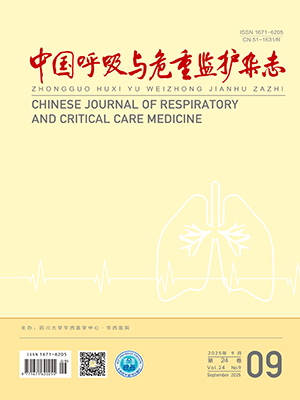| 1. |
Hobbs BD, Putman RK, Araki T, et al. Overlap of genetic risk between interstitial lung abnormalities and idiopathic pulmonary fibrosis. Am J Respir Crit Care Med, 2019 Jul 24.[Epub ahead of print] doi: 10.1164/rccm.201903-0511OC.
|
| 2. |
Allen RJ, Porte J, Braybrooke R, et al. Genetic variants associated with susceptibility to idiopathic pulmonary fibrosis in people of European ancestry: a genome-wide association study. Lancet Respir Med, 2017, 5(11): 869-880.
|
| 3. |
Fingerlin TE, Zhang W, Yang IV, et al. Genome-wide imputation study identifies novel HLA locus for pulmonary fibrosis and potential role for auto-immunity in fibrotic idiopathic interstitial pneumonia. BMC Genet, 2016, 17(1): 74.
|
| 4. |
李炯, 苏立. 特发性肺纤维化病情评估和预后生物标志物的研究进展. 重庆医学, 2017, 46(25): 3591-3594.
|
| 5. |
Conti C, Montero-Fernandez A, Borg E, et al. Mucins MUC5B and MUC5AC in distal airways and honeycomb spaces: comparison among idiopathic pulmonary fibrosis/usual interstitial pneumonia, fibrotic nonspecific interstitial pneumonitis, and control lungs. Am J Respir Crit Care Med, 2016, 193(4): 462-464.
|
| 6. |
Byun EB, Kim WS, Sung NY, et al. Epigallocatechin-3-gallate regulates anti-inflammatory action through 67-kDa laminin receptor-mediated Tollip signaling induction in lipopolysaccharide-stimulated human intestinal epithelial cells. Cell Physiol Biochem, 2018, 46(5): 2072-2081.
|
| 7. |
Lorenzo-Salazar JM, Ma SF, Jou J, et al. Novel idiopathic pulmonary fibrosis susceptibility variants revealed by deep sequencing. ERJ Open Res, 2019, 5(2): 00071-2019.
|
| 8. |
Chen G, Ribeiro CMP, Sun L, et al. XBP1S regulates MUC5B in a promoter variant-dependent pathway in IPF airway epithelia. Am J Respir Crit Care Med, 2019, 200(2): 220-234.
|
| 9. |
Raghu G, Remy-Jardin M, Myers JL, et al. Diagnosis of idiopathic pulmonary fibrosis. An Official ATS/ERS/JRS/ALAT Clinical Practice Guideline. Am J Respir Crit Care Med, 2018, 198(5): e44-e68.
|
| 10. |
Maldonado F, Moua T, Rajagopalan S, et al. Automated quantification of radiological patterns predicts survival in idiopathic pulmonary fibrosis. Eur Respir J, 2014, 43(1): 204-212.
|
| 11. |
Olson AL, Swigris JJ, Belkin A, et al. Physical functional capacity in idiopathic pulmonary fibrosis: performance characteristics of the continuous-scale physical function performance test. Expert Rev Respir Med, 2015, 9(3): 361-367.
|
| 12. |
Wakamatsu K, Nagata N, Kumazoe H, et al. Prognostic value of serial serum KL-6 measurements in patients with idiopathic pulmonary fibrosis. Respir Investig, 2017, 55(1): 16-23.
|
| 13. |
Neighbors M, Cabanski CR, Ramalingam TR, et al. Prognostic and predictive biomarkers for patients with idiopathic pulmonary fibrosis treated with pirfenidone: post-hoc assessment of the CAPACITY and ASCEND trials. Lancet Respir Med, 2018, 6(8): 615-626.
|
| 14. |
Hata A, Nakajima T, Matsusaka K, et al. A low DNA methylation epigenotype in lung squamous cell carcinoma and its association with idiopathic pulmonary fibrosis and poorer prognosis. Int J Cancer, 2019 Jun 26. [Epub ahead of print] doi: 10.1002/ijc.32532.
|
| 15. |
Kumar A, Dougherty M, Findlay GM, et al. Genome sequencing of idiopathic pulmonary fibrosis in conjunction with a medical school human anatomy course. PLoS One, 2014, 9(9): e106744.
|
| 16. |
Scholand MB, Wolff R, Crossno PF, et al. Severity of cough in idiopathic pulmonary fibrosis is associated with MUC5 B genotype. Cough, 2014, 10(1): 3.
|
| 17. |
Plantier L, Crestani B, Wert SE, et al. Ectopic respiratory epithelial cell differentiation in bronchiolised distal airspaces in idiopathic pulmonary fibrosis. Thorax, 2011, 66(8): 651-657.
|
| 18. |
Zhang Q, Wang Y, Qu D, et al. The possible pathogenesis of idiopathic pulmonary fibrosis considering MUC5B. BioMed Res Int, 2019, 2019: 9712464.
|
| 19. |
Peljto AL, Selman M, Kim DS, et al. The MUC5B promoter polymorphism is associated with idiopathic pulmonary fibrosis in a Mexican cohort but is rare among Asian ancestries. Chest, 2015, 147(2): 460-464.
|
| 20. |
Latsi PI, du Bois RM, Nicholson AG, et al. Fibrotic idiopathic interstitial pneumonia: the prognostic value of longitudinal functional trends. Am J Respir Crit Care Med, 2003, 168(5): 531-537.
|
| 21. |
Collard HR, King TE Jr, Bartelson BB, et al. Changes in clinical and physiologic variables predict survival in idiopathic pulmonary fibrosis. Am J Respir Crit Care Med, 2003, 168(5): 538-542.
|
| 22. |
Chung JH, Peljto AL, Chawla A, et al. CT imaging phenotypes of pulmonary fibrosis in the MUC5B promoter site polymorphism. Chest, 2016, 149(5): 1215-1222.
|
| 23. |
Best AC, Meng J, Lynch AM, et al. Idiopathic pulmonary fibrosis: physiologic tests, quantitative CT indexes, and CT visual scores as predictors of mortality. Radiology, 2008, 246(3): 935-940.
|
| 24. |
Ishii H, Kushima H, Kinoshita Y, et al. The serum KL-6 levels in untreated idiopathic pulmonary fibrosis can naturally decline in association with disease progression. Clin Respir J, 2018, 12(9): 2411-2418.
|
| 25. |
Mertens JS, de Jong E, van den Hoogen LL, et al. The identification of CCL18 as biomarker of disease activity in localized scleroderma. J Autoimmun, 2019, 101: 86-93.
|
| 26. |
Vuga LJ, Tedrow JR, Pandit KV, et al. CXC motif chemokine 13(CXCL13) is a prognostic biomarker of idiopathic pulmonary fibrosis. Am J Respir Crit Care Med, 2014, 189(8): 966-974.
|
| 27. |
Jiang H, Hu Y, Shang L, et al. Association between MUC5B polymorphism and susceptibility and severity of idiopathic pulmonary fibrosis. Int J Clin Exp Pathol, 2015, 8(11): 14953-14958.
|




